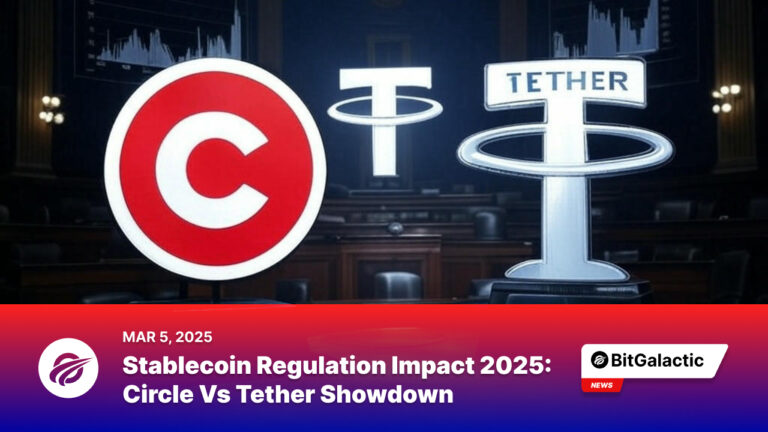Stablecoin Regulation Impact 2025: Circle vs Tether Showdown.
Hey, crypto fam! It’s your host from BitGalactic, your go-to crypto nerd with 10 years in the game. Imagine this: the U.S. Senate is about to drop a stablecoin law that could flip the market upside down. Circle’s playing chess while Tether’s swinging fists—and oh boy, it’s getting spicy. Stick around because I’ve got the scoop, some wild predictions, and a decade of crypto wisdom to break it all down. Let’s dive in!
So here’s the deal: Circle, the slow-and-steady player behind USDC, is cheering for this new GENIUS Act. Why? It’s all about federal oversight—think audits, transparency, and a legit ‘level playing field.’ Circle’s already cozy with regulators, audited by Deloitte since 2022, and based in New York. They’re like that kid in class who’s always prepared for the pop quiz. Meanwhile, Tether, the $142 billion gorilla in the room, is raging against the machine. Their CEO, Paolo Ardoino, just blasted ‘lawfare’ on X—basically saying rivals are weaponizing laws to take them down.
Now, I’ve been watching stablecoins since the early days, and here’s my take: Circle’s compliance obsession could be their golden ticket. The market cap of USDC is hovering around $55 billion as of March 2025—still dwarfed by Tether’s USDT—but with U.S. rules tightening, that gap might shrink fast. Tether’s been king because they moved quick, dodged rules, and parked offshore—now in El Salvador. But dodging Europe’s MiCA laws cost them listings on exchanges there, and the U.S. could be next.
Let’s talk numbers: stablecoin trading volume hit $1.2 trillion last quarter, per CoinGecko, and 60% of that was USDT. But here’s the kicker—Circle’s been growing 15% quarter-over-quarter in institutional adoption. Why? Big players like Goldman Sachs back them, and banks love that audit trail. Tether? They’re still a black box to some, and that’s a risk in this new regulated world.
This isn’t the first time we’ve seen a crypto showdown like this. Rewind to 2017—Bitcoin vs. Bitcoin Cash. One stuck to the core vision; the other went rogue for faster scaling. Tether’s that rogue right now, betting on speed and dominance, while Circle’s playing the long game like Bitcoin did. Back then, the market rewarded adaptability—Bitcoin Cash faded, and BTC soared.
Or take stablecoins in 2021: Remember when Terra’s UST crashed? Regulation talks spiked, and compliant players like Circle weathered the storm better. Tether survived too, but their opacity took a PR hit. History says the market loves winners who bend with the rules—not break them. Could this be Tether’s Achilles’ heel?
So what’s next? If this GENIUS Act passes—and momentum’s building with bipartisan buzz—it could force Tether to register in the U.S. or lose ground. Circle might snag 20-30% more market share by 2026, especially if institutions pile in. But Tether’s not going down without a fight—they’ve got loyal users and a decade of hustle. My bold call? Stablecoins hit a $500 billion market cap by 2027, with Circle and Tether neck-and-neck if regs tighten.
What do you think? Will Circle overtake Tether, or does Tether’s rebel vibe keep them on top? Drop your predictions in the comments—I’m reading every one!
If you loved this deep dive, hit that subscribe button and ring the bell! We’re unpacking crypto chaos every week—10 years of experience, zero fluff. Join the BitGalactic crew, and let’s ride this wild market together. Catch you in the next one—stay galactic!
Share this post


